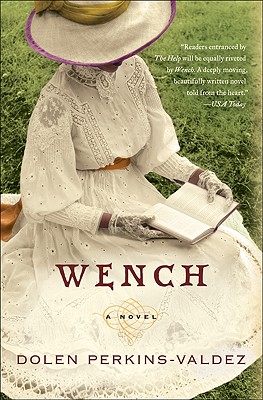Book Review: Wench: A Novel
by Dolen Perkins-Valdez
List Price: $24.99Amistad (Jan 05, 2010)
Fiction, Hardcover, 304 pages
More Info ▶
Book Reviewed by Thumper
I had a feeling that even though we are educated enough in the
institution of slavery, there are still aspects that take me by surprise.
Dolen Perkins-Valdez debut novel, Wench, is about one of those little
surprises. The story takes place in an 1853 Ohio vacation resort which
serves as an intersection of time and place for a group of the
slave/mistress and their masters. The novel delves into the
relationships between the women and their masters, and each other.
Wench is a graceful, unassumingly powerful
novel that was infectious. I loved it, a highly impressive debut
novel.
The novel centers around one couple in particular, Lizzie and
Nathan Drayle. Lizzie is the mistress and house slave of Nathan
Drayle, a poor horseman who married Francesca, who comes from a Southern
family with means. During Lizzie’s relationship with Nathan, she has
two children. Francesca is unable to have children. As Nathan’s
and Lizzie’s relationships begin to change, Nathan begins taking Lizzie to
Tawawa House, a hotel/resort in Ohio.
Tawawa House has become the resort of choice for white Southern
slave owners to bring their black slave/mistress for summer vacations.
The white men can openly display their relationships with the female slaves
in a more relaxed social atmosphere and without the presences of their wives
or southern society. As Lizzie’s and Nathan’s summer vacation develop
into an annual happening, Lizzie forms relationships with the other
slave/mistress: Reenie, Sweet and the newest addition, Mawu. As the
stories of their lives and relationships with their masters unfold, the
women contemplate freedom, what it means to be free and the consequences for
daring to ponder or dream of it.
I loved Wench and I was not
expecting to. When I read the summary of
Wench, I thought, a slave novel with four sista-girlfriends angle.
How interesting? *rolling my eyes* Now, I get to hear about
Torneisha’s great great grandmamma being head slave in the kitchen since
there is no Human Resource department for her to be VP of. I took the old
knife sharpening stone out, got my knife paper sharp and I got ready to do
some cutting, because I knew there was going to be blood spilt on the floor
before I got done. Perkins-Valdez fooled me. Wench turned out to
be an exciting read!
As I read the first few pages, it became real obvious that this
novel was far more than my cynical perception of the slavery version of a
sista-girlfriend book. Wench covered
the degradation, inhumanity, and humiliation of slavery; nothing is missed
or skimmed over. Perkins-Valdez provided a surprising little
bent to the traditional slave narrative by introducing Tawawa House, a
summer resort "in a free state" that specialized as a place where white men
can openly display their sexual relationships with their slave/mistress
without the eyes of the wives looking and telling.
First, I was, almost, barely, tempted to pooh pooh the idea of
slave owners going to a northern vacation resort to be with their slave
mistress. Then, I thought again. Goodness knows, those white men
were low down enough to pull off something like this and think nothing of
it. Low-rent, bargain basement morality should come as no surprise for
white men who owned slaves. I came to believe that these types of
"vacations", to the slave owners, could be seen as "normal".
The characters are well developed and multi-dimensional. I
have to admire Perkins-Valdez and her creation of Lizzie. My feelings
for Lizzie were taken for a ride on a roller coaster. Early in the
novel, Lizzie does something that caused me to hate her guts! When I
reached the second part of the novel, my heart sank in dread because it
focused on Lizzie, how her relationship with Nathan began, bringing me up to
the story present. Once I got over my hostility towards Lizzie, I was
able to hear the story about Lizzie-Nathan relationship and see the dynamics
and the power struggle between the two.
Perkins-Valdez showed, through the other three slaves, Reenie,
Sweet, and Mawu a variation of the slave owner-slave mistress relationship.
While, Lizzie is the star of the show; the other three women was vital in
order to establish a balance. I got to see what the relationship was
like when the owner and the slave had NO affection for each other (Mawu and
her owner Tip); an incestuous relationship (Reenie and her owner Sir); a
"caring" relationship (Sweet and her owner). No matter the status of
the relationship, each of the women would learn, without the slightest doubt
that they were just slaves, powerless because they were women in a man’s
world. Through Lizzie, Perkins-Valdez illustrated that although the
women were not free, physically, but mentally, emotionally, no one can take
or own their ability to love themselves. This lesson is one that is as
important today as it was those generations ago.

